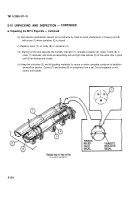TM-9-2350-311-10 - Page 626 of 775
TM9-2350-311-10
5-16 PREPARATION FOR FIRING
a. M823 Projectile
For training purposes, the M823 training projectile will be used instead of the M712 projectile. All operational
procedures which apply to the M712 projectile also apply to the M823 projectile. However, no live propelling charges
are to be used with the M823 training projectile.
b. M712 Projectile
• Cannon tube forcing cone must be free of oil and grease before ramming. Oil or grease may
permit projectile fallback, causing possible injury to personnel.
• After extracting an M712 projectile from a hot cannon tube, clean the forcing cone of melted
plastic. Failure to do so may result in projectile fallback causing possible injury to personnel.
Cleaning may be accomplished by firing another type projectile, if mission requirements
permits, or firing a propelling charge alone.
1
Unpack and inspect the M712 projectile or M823 projectile (para 5-15).
2 Make sure that the projectile extractor is set up and ready for use (para 5-18).
3 After unpacking the M712 projectile (1), the Fire Direction Center (FDC) will announce the code switch
(2) and time switch (3) setting in the fire command in the same place as they usually send ‘lime” for
Time or VT fuzes. This setting will always have five numbers. Code and time switches will be set from
left to right as seen when facing the nose of the projectile from the base of the round. Code and time
switches are circular dials that can be rotated clockwise or counterclockwise as many times as required
without damage. The appropriate number on the code and time switches must be centered on the scribe
line. Set the code and time switches using a screwdriver or the tang end of the M18 fuze-setter wrench
as follows.
NOTE
•
Be sure to set code and time switches in correct sequence. Always set first switch on left
(looking from base of projectile toward nose) first, then the next switch to the right, etc., until
all five switches have been set.
• A noticeable click should occur at each number on the code and time switch. This click may
be heard and/or felt.
(a) Rotate code switch (2) and time switch (3) at least one complete turn, either clockwise or
counterclockwise.
(b) Continue turning code switch (2) or time switch (3) past correct number and toward the next
adjacent number, but stop before reaching next number.
5-88
Back to Top




















